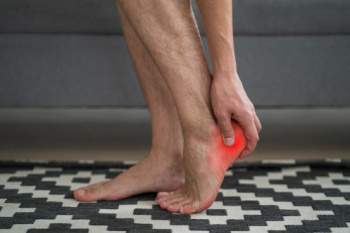Items filtered by date: November 2024
How Falling Affects the Feet

Falling can significantly effect the feet, especially as people age. When an individual falls, the feet may suffer from sprains, fractures, or bruises. For older adults, the risk is heightened due to age-related changes in the feet. As one ages, the muscles and ligaments in the feet weaken, reducing balance and stability. The fat pads on the soles of the feet thin out, offering less cushioning and making the feet more vulnerable to injury upon impact. Additionally, conditions like arthritis, poor circulation, and reduced flexibility in aging feet can complicate recovery after a fall. Even minor injuries can cause lasting discomfort or difficulty walking. To protect the feet, it is important to wear supportive footwear, engage in balance-strengthening exercises, and ensure a safe living environment to prevent falls and reduce the risk of injury. If you have endured a foot injury from falling, it is suggested that you make an appointment with a podiatrist.
Preventing falls among the elderly is very important. If you are older and have fallen or fear that you are prone to falling, consult with one of our podiatrists from Highlands Foot and Ankle. Our doctor will assess your condition and provide you with quality advice and care.
Every 11 seconds, an elderly American is being treated in an emergency room for a fall related injury. Falls are the leading cause of head and hip injuries for those 65 and older. Due to decreases in strength, balance, senses, and lack of awareness, elderly persons are very susceptible to falling. Thankfully, there are a number of things older persons can do to prevent falls.
How to Prevent Falls
Some effective methods that older persons can do to prevent falls include:
- Enrolling in strength and balance exercise program to increase balance and strength
- Periodically having your sight and hearing checked
- Discuss any medications you have with a doctor to see if it increases the risk of falling
- Clearing the house of falling hazards and installing devices like grab bars and railings
- Utilizing a walker or cane
- Wearing shoes that provide good support and cushioning
- Talking to family members about falling and increasing awareness
Falling can be a traumatic and embarrassing experience for elderly persons; this can make them less willing to leave the house, and less willing to talk to someone about their fears of falling. Doing such things, however, will increase the likelihood of tripping or losing one’s balance. Knowing the causes of falling and how to prevent them is the best way to mitigate the risk of serious injury.
If you have any questions, please feel free to contact our office located in Waco, TX . We offer the newest diagnostic and treatment technologies for all your foot care needs.
Custom Orthotics For Ankle Stability

Step with assurance, thanks to enhanced ankle stability from orthotics! If you're active and on the move, Custom Orthotics are your ally for stronger, steadier ankles. They align your foot and ankle, reducing the risk of sprains and offering solid support for every stride. Don’t let instability hold you back. Try Custom Orthotics from our office, and discover unshakable confidence in every step!
Causes of Heel Pain While Walking

Heel pain while walking is a common issue that can stem from various causes. One of the most prevalent reasons is plantar fasciitis, an inflammation of the tissue that runs along the bottom of the foot. Overuse from excessive walking or running can also contribute to heel pain, particularly in individuals who do high-impact activities. Other factors include wearing improper footwear, which may lack support or cushioning, and conditions like Achilles tendinitis or heel spurs. To find relief, it is important to rest and reduce activity levels, allowing the heel to heal. Stretching exercises for the calves and plantar fascia can improve flexibility. Additionally, using supportive footwear or custom orthotics can provide the necessary support. Heel pain can cause difficulty in completing daily tasks, and it is suggested that a podiatrist is consulted who can determine what the cause is, and offer appropriate treatment solutions.
Many people suffer from bouts of heel pain. For more information, contact one of our podiatrists of Highlands Foot and Ankle. Our doctor can provide the care you need to keep you pain-free and on your feet.
Causes of Heel Pain
Heel pain is often associated with plantar fasciitis. The plantar fascia is a band of tissues that extends along the bottom of the foot. A rip or tear in this ligament can cause inflammation of the tissue.
Achilles tendonitis is another cause of heel pain. Inflammation of the Achilles tendon will cause pain from fractures and muscle tearing. Lack of flexibility is also another symptom.
Heel spurs are another cause of pain. When the tissues of the plantar fascia undergo a great deal of stress, it can lead to ligament separation from the heel bone, causing heel spurs.
Why Might Heel Pain Occur?
- Wearing ill-fitting shoes
- Wearing non-supportive shoes
- Weight change
- Excessive running
Treatments
Heel pain should be treated as soon as possible for immediate results. Keeping your feet in a stress-free environment will help. If you suffer from Achilles tendonitis or plantar fasciitis, applying ice will reduce the swelling. Stretching before an exercise like running will help the muscles. Using all these tips will help make heel pain a condition of the past.
If you have any questions please contact our office located in Waco, TX . We offer the newest diagnostic and treatment technologies for all your foot and ankle needs.
Key Facts About Ingrown Toenails

An ingrown toenail occurs when the edge of a toenail grows into the surrounding skin, leading to pain and discomfort. This condition commonly affects the big toe and can result from various factors, including improper nail trimming, wearing tight footwear, or injury to the toe. Individuals with naturally curved toenails may also be more susceptible to developing this issue. Symptoms of an ingrown toenail include localized pain, redness, swelling, and sometimes pus drainage, indicating potential infection. As the condition worsens, walking and wearing shoes may become increasingly uncomfortable. Prompt attention to an ingrown toenail is important to alleviate pain and prevent further complications. If you have developed an ingrown toenail, it is strongly suggested that you seek prompt attention from a podiatrist who can treat this condition, perhaps involving surgery.
Ingrown toenails can become painful if they are not treated properly. For more information about ingrown toenails, contact one of our podiatrists of Highlands Foot and Ankle. Our doctor can provide the care you need to keep you pain-free and on your feet.
Ingrown Toenails
Ingrown toenails occur when a toenail grows sideways into the bed of the nail, causing pain, swelling, and possibly infection.
Causes
- Bacterial infections
- Improper nail cutting such as cutting it too short or not straight across
- Trauma to the toe, such as stubbing, which causes the nail to grow back irregularly
- Ill-fitting shoes that bunch the toes too close together
- Genetic predisposition
Prevention
Because ingrown toenails are not something found outside of shoe-wearing cultures, going barefoot as often as possible will decrease the likeliness of developing ingrown toenails. Wearing proper fitting shoes and using proper cutting techniques will also help decrease your risk of developing ingrown toenails.
Treatment
Ingrown toenails are a very treatable foot condition. In minor cases, soaking the affected area in salt or antibacterial soaps will not only help with the ingrown nail itself, but also help prevent any infections from occurring. In more severe cases, surgery is an option. In either case, speaking to your podiatrist about this condition will help you get a better understanding of specific treatment options that are right for you.
If you have any questions please feel free to contact our office located in Waco, TX . We offer the newest diagnostic and treatment technologies for all your foot and ankle needs.
Causes of Ankle Pain When Walking

Ankle pain when walking can have several causes, ranging from injury to underlying medical conditions. Common injuries like sprains or strains occur when ligaments or muscles in the ankle are overstretched or torn, often from twisting or rolling the ankle. Ankle bruising, fractures, or breaks can also result in significant discomfort, especially when weight is placed on the joint. Conditions such as osteoarthritis and gout can lead to chronic ankle pain. Osteoarthritis pain is the result of cartilage breakdown between the bones, while gout is inflammation caused by the buildup of uric acid crystals in the ankle joint. A podiatrist can diagnose the cause of ankle pain and offer appropriate treatment options. If you experience ankle pain when you walk, it is suggested that you schedule an appointment with a podiatrist for an evaluation and treatment.
Ankle pain can have many different causes and the pain may potentially be serious. If you have ankle pain, consult with one of our podiatrists from Highlands Foot and Ankle. Our doctor will assess your condition and provide you with quality foot and ankle treatment.
Ankle pain is any condition that causes pain in the ankle. Due to the fact that the ankle consists of tendons, muscles, bones, and ligaments, ankle pain can come from a number of different conditions.
Causes
The most common causes of ankle pain include:
- Types of arthritis (rheumatoid, osteoarthritis, and gout)
- Ankle sprains
- Broken ankles
- Achilles tendinitis
- Achilles tendon rupture
- Stress fractures
- Tarsal tunnel syndrome
- Plantar fasciitis
Symptoms
Symptoms of ankle injury vary based upon the condition. Pain may include general pain and discomfort, swelling, aching, redness, bruising, burning or stabbing sensations, and/or loss of sensation.
Diagnosis
Due to the wide variety of potential causes of ankle pain, podiatrists will utilize a number of different methods to properly diagnose ankle pain. This can include asking for personal and family medical histories and of any recent injuries. Further diagnosis may include sensation tests, a physical examination, and potentially x-rays or other imaging tests.
Treatment
Just as the range of causes varies widely, so do treatments. Some more common treatments are rest, ice packs, keeping pressure off the foot, orthotics and braces, medication for inflammation and pain, and surgery.
If you have any questions, please feel free to contact our office located in Waco, TX . We offer the newest diagnostic and treatment technologies for all your foot care needs.

